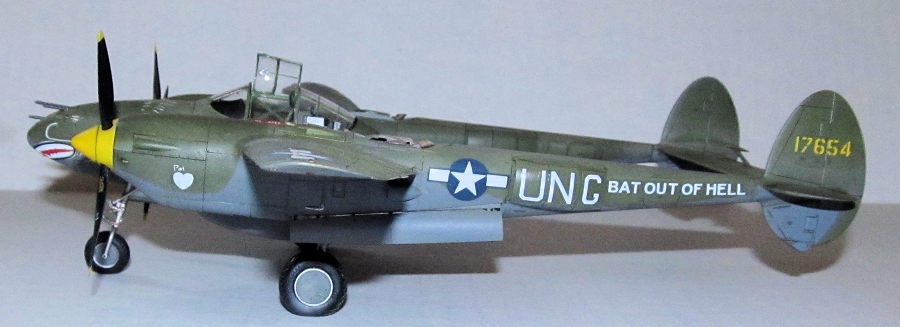
Tamiya 1/48 P-38F/G Lightning
| KIT #: | 61120 |
| PRICE: | $80.00 SRP, cheaper if you look around |
| DECALS: | Two options |
| REVIEWER: | Dan Lee |
| NOTES: | Eduard Resin Tires, Eduard Steel Seat Belt and Xtradecals Sheet 48214 |

| HISTORY |
The P-38 Lightning was originally planned to be a high altitude twin engined bomber interceptor. It was designed by Clarence Kelly Johnson's team with its now famous and unique twin boom configuration around the turbo-supercharged engines and weapons. Unlike the P-39 Aircobra, the original turbo-superchargers were not deleted by the Army Air Corps and it kept its high altitude performance.
During the prototype testing phase,
it suffered from what was claimed to be tail flutter during a high speed dive
which wasn't actually the case. The design changes suggest by the US Army
included the prominent tail masses on the central stabilizer which didn't do
anything. It wasn't till Kelly Johnson with USAAC support demanded that the NACA
do tests in its high speed
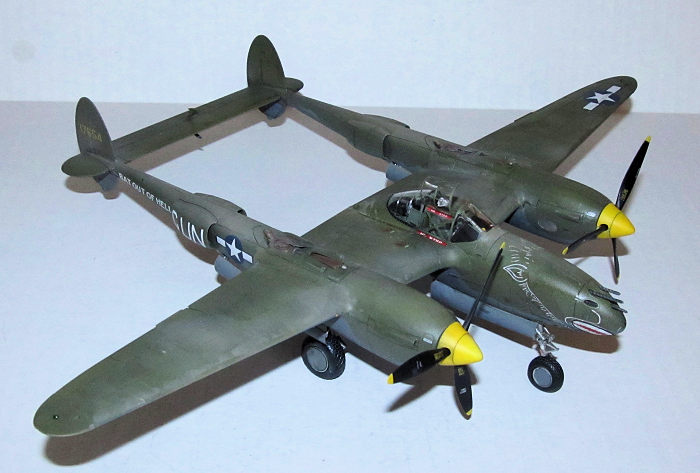 wind tunnel in 1943 which identified the actual
problem. The problem was actually due to the changing center of pressure towards
the tail at high speeds. This would be remedied by adding quick acting dive
flaps to the outboard side of the engine nacelles added to the late J/L model
P-38s.
wind tunnel in 1943 which identified the actual
problem. The problem was actually due to the changing center of pressure towards
the tail at high speeds. This would be remedied by adding quick acting dive
flaps to the outboard side of the engine nacelles added to the late J/L model
P-38s.
It carried a concentrated firepower of four .50 caliber machine guns and one 20mm cannon. The US Army tried the 37mm cannon instead of the 20mm one, but it proved impractical and useless in testing so the USAAF wisely kept the 20mm cannon.
It would fight in all operations theaters during WW2. Despite past aviation histories proclaiming the Germans called it the Forked Tailed Devil, the Luftwaffe had mixed opinions on the P-38. Some felt it was an easy kill while others viewed it as a dangerous opponent to be respected. It would prove to be more dangerous in the Pacific thanks to its long range and the adoption of energy dogfighting tactics (high speed diving attacks, etc) rather than committing to a turning fight which would have given a major advantage to the Japanese.
The 1st Fighter Group was originally planned to be deployed in the Pacific, but changing priorities forced it to deploy to England (first fighters to be flown across the Atlantic instead of carried by ship.) As the losses mounted in Operation Torch, the 1st Fighter Group was reassigned to the 12th AF and sent to the Mediterranean. The inexperienced 1st Fighter Group faced off against the combat experienced Axis Air Forces and suffered heavy losses due to combination of poor tactics and trying to do things the Lightning didn't do very well like close in dogfight.
Eventually the USAAF sent the 82nd Fighter Group from England as well as strip any Lightning unit of their P-38s and pilots to replace losses.
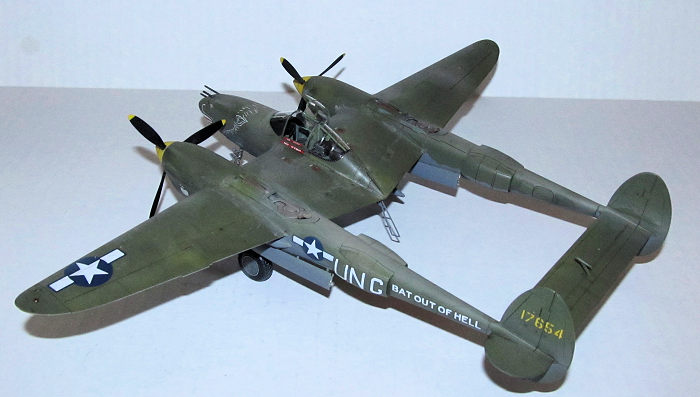 The famous Hat In The Ring squadron, the 94th
Fighter Squadron was part of the 1st Fighter Group. It would fly in
all the campaigns from the Med to Europe with the P-38.
The famous Hat In The Ring squadron, the 94th
Fighter Squadron was part of the 1st Fighter Group. It would fly in
all the campaigns from the Med to Europe with the P-38.
Lt. James Hagenback was a pilot assigned to the 94th Fighter Squadron. He was the pilot of “Bat Out of Hell” which became a famous P-38 scheme. I don't have much information on James' war service except that he survived the war and died of cancer in 1998. What I learned was that he was a friend of Major Fredric Arnold, an artist who graduated in the same pilot training class and survived 50 missions in the P-38. Only James and Fredric survived the war out of the 14 who graduated. They made a vow that the last man to survive do something to honor the 12 who didn't return home. A few years after James died, Fredric made 12 sculptures based on a vignette he drew on a map in the briefing room which he still had. He purposely kept the faces generic instead of looking like his dead comrades for obvious reasons. Fredric with help from other sculpturists completed the bronze sculpture diorama in 2015 and had it dedicated at the World War 2 Museum in New Orleans in 2016. Fredric Arnold died in 2018 at the age of 96.
Background info quickly summarized from Wiki
https://lestweforgetsculpture.org/
| THE KIT |
Please see Scott's preview of the kit to see what is in the box (under T for Tamiya).
| CONSTRUCTION |
It all began with painting the various interior parts. I borrowed/stole from Tom Cleaver's P-38 research/review the use of British Interior Green (Tamiya XF-71 which is a close approximation) for the cockpit color. The various parts were painted and the fine surface details were painted with a 0 tip paint brush as per Tamiya's paint guide.
 Next the multipart landing gear
well parts were airbrushed first with Black Stynylrez primer and then when dry
sprayed Vallejo Metal Color Aluminum. Various details were brush painted before
installation The various landing gear was cut off from the sprue tree. The parts
were cleaned up of mold marks and sprue nubs using a knife and sandpaper. These
were then painted in two steps the same way as the landing gear well parts.
Next the multipart landing gear
well parts were airbrushed first with Black Stynylrez primer and then when dry
sprayed Vallejo Metal Color Aluminum. Various details were brush painted before
installation The various landing gear was cut off from the sprue tree. The parts
were cleaned up of mold marks and sprue nubs using a knife and sandpaper. These
were then painted in two steps the same way as the landing gear well parts.
The props are engineered to make painting the hubs easy to do without a lot of masking required unlike the Hasegawa version. The various parts were cleaned up and then painted; the hubs sprayed with flat white first then flat yellow while the prop blades were painted flat black primer first then the tips painted flat white and later flat yellow. FYI, Tamiya supplies the decals for the tips, but I've never any success with prop tip decals which is why I just prefer to paint them. Once the paint was dry, the prop hubs were assembled.
The cockpit parts were cut from the sprue trees, cleaned up and assembled together. Please follow the instruction order as failure to do so may cause some frustration later down the road. The cockpit was quite easy to assemble. I used Eduard steel Photo Etch Seatbelts instead of the decal Tamiya provides-secured with CA glue. The mostly completed cockpit and nose wheel well interiors snapped into bottom half of the centerline pod.
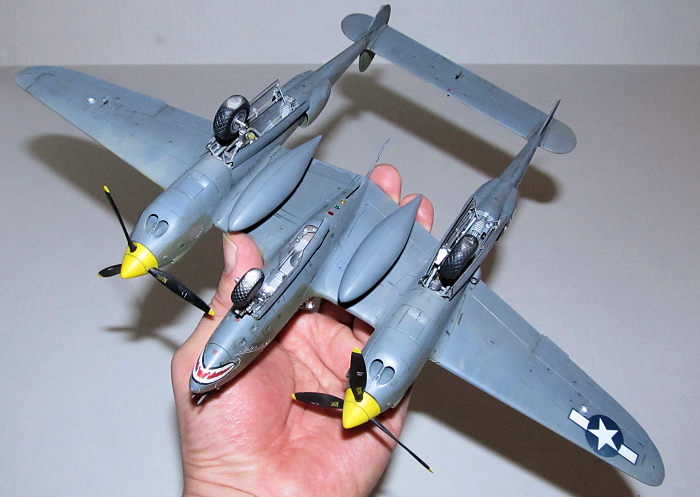 Again following the instructions, I
plopped in the supplied nose weight, glued the top of the wing and the
centerline pod to the bottom half of the pod and wings using CA glue for the
visible seams and Tamiya Extra Thin for the interior joins. The fit was almost
perfect. It only required a touch of sanding to clean up the seams.
Again following the instructions, I
plopped in the supplied nose weight, glued the top of the wing and the
centerline pod to the bottom half of the pod and wings using CA glue for the
visible seams and Tamiya Extra Thin for the interior joins. The fit was almost
perfect. It only required a touch of sanding to clean up the seams.
The main gear wells were assembled next. Again, it is very important to follow the order in the instructions and it will save you some grief later. The various sub assemblies and weights were aded to each boom before they were closed up. I only used CA glue on the rudders and certain areas forward while I used Tamiya Extra Thin everywhere else. I'm sure that the few folks who follow my reviews are asking “Why didn't I do the same for the booms?” Especially since I have an obsession about avoiding the dreaded phantom seam. The answer is I don't need to as the seams are supposed to be there on the P-38. Top marks to the Tamiya design/engineering team for using that detail to delete sanding/filling during assembly. I glued on the remaining boom parts minus the intercoolers and added each boom to the centerline pod and wing assembly. Unlike the Hasegawa kit there are no issues with gaps between the wings and engine booms which drove me crazy at the time.
Next I added the remaining parts like the centerline stabilizer and the top of each engine boom minus the separate intercooler parts. Also I glued together the fuel tanks and pylons.
I left off the wing tips and ailerons off in my desire to paint Bat Outta Hell with yellow leading edges and wing tips. Also I left off the nose and tailplane tips because I didn't want a headache masking.
| COLORS & MARKINGS |
Based on the photos of Tom's photos of Glacier Girl, I used British Dark Green instead of USAAF Olive Drab to represent the early P-38s. The model was masked off and gear wells stuffed with sponges before it was primed with Black Stynylrez primer. When dry the model's rough patches were polished a bit using 3200 and 3600 polishing cloths.
First I sprayed on the underside neutral grey. I used Tamiya's a little bit too dark XF-53 Neutral Grey mixed with about flat white (ratio of 9/1). After it dried, I masked off the leading edges and wing tips and sprayed on flat white and then flat yellow.
 I masked those yellow areas off and
the underside using hand cut tape masks and then sprayed on a blotchy coat of
British Dark Green for the rest of the model.
I masked those yellow areas off and
the underside using hand cut tape masks and then sprayed on a blotchy coat of
British Dark Green for the rest of the model.
Tamiya supplies canopy masks and I used them to mask the complicated canopy of the P-38. These were painted with the interior color first then the exterior.
At this point I had painted the supercharger intercoolers and glued them in place.
I had my heart set on recreating Bat Out of Hell. I really liked its unique look with the yellow wing tips and leading edges which was based on assumptions/observations from a photo taken in 1943. As I showed my P-38 in progress photos on the forum, Lee Kolosna who built a Hasegawa P-38 with the same markings mentioned that he was contacted by James Hagenback's son after his review was posted up, who said that the only thing yellow on his father's P-38 were the prop hubs. Lee also pointed out that the leading edges were more than likely OD/Neutral Grey and the yellow leading edges were pretty much a guess based on the desert lighting in a photo than anything real. After thinking about it for a few minutes and looking at the photos I could find on the internet, I realized that James' son and Lee made good points so I sadly painted over the yellow leading edges and wingtips. Admittedly the model would look flashy with yellow leading edges and wingtips, but I preferred to be historically accurate. I sprayed on the gloss coat (Vallejo gloss) and then let it dry for a day before starting on the decals.
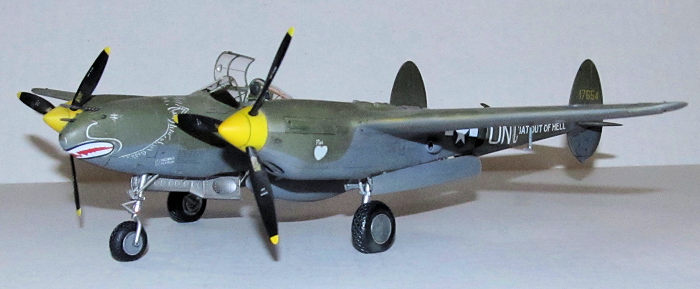 The Xtradecal decals for Bat Out of
Hell went on okay, but I had some issues with the bat mouth because it folded. I
guess I was lucky I used Microset instead of the much stronger Solvaset or you
would be reading up how I turned the decals into a complete fiasco/picked a new
paint scheme. In the end it took an hour of gentle coaxing and swearing to get
the bat mouth unfolded without ripping up the decal.
The Xtradecal decals for Bat Out of
Hell went on okay, but I had some issues with the bat mouth because it folded. I
guess I was lucky I used Microset instead of the much stronger Solvaset or you
would be reading up how I turned the decals into a complete fiasco/picked a new
paint scheme. In the end it took an hour of gentle coaxing and swearing to get
the bat mouth unfolded without ripping up the decal.
One should not be surprised that the P-38 Lightning comes with a multitude of stencils. It took several hours of work scattered over a week to put all the stencils on. For a while, I felt I was working on a modern jet not a WW2 fighter.
I used a watercolor wash to dirty up the P-38 and various unassembled parts. The excess removed with damp Q-Tips. Certain areas got an enamel wash (Tamiya Black and Vallejo Desert) to dirty things up. Exhaust stains were sprayed on (dark grey and buff were used) for the intercoolers. At this point I sprayed on Tamiya Flat clear to seal everything in.
| FINAL CONSTRUCTION |
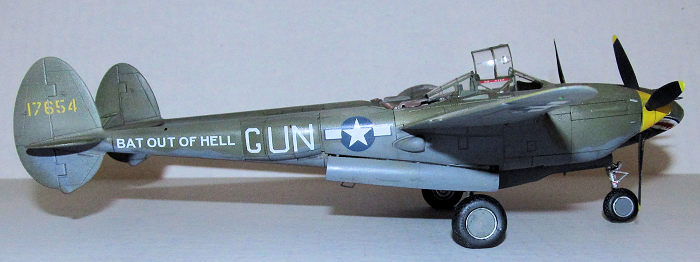 The landing gear doors were added.
I admired the effort that Tamiya put into making these an easy solid join unlike
the Hasegawa kit. I didn't even glue them in place. After that, the landing gear
was added. Again, the P-38 main landing gear is complex assembly, but Tamiya
made it easier to assemble (again, IIRC those were a headache when building the
Hase.)
The landing gear doors were added.
I admired the effort that Tamiya put into making these an easy solid join unlike
the Hasegawa kit. I didn't even glue them in place. After that, the landing gear
was added. Again, the P-38 main landing gear is complex assembly, but Tamiya
made it easier to assemble (again, IIRC those were a headache when building the
Hase.)
The gun barrels were painted, inserted into the prepainted nose and glued in place. Various small parts were painted and then glued in place including the unmasked canopy pieces. The Eduard resin wheels looked a lot better than the Tamiya ones. These were painted and then weathered. I clipped off part of the landing gear peg before gluing it in place with CA glue.
About the only thing I didn't do was the radio wire. Maybe in the future, but I am okay with the model as it was. In the end, Tamiya's P-38F with Bat Outta Hell markings was completed in less than 25 hours of work covering almost 3 weeks.
| CONCLUSIONS |
The Tamiya P-38F is the best model kit I have ever built and deserving of all the praise and accolades. You really can't screw it up unless you really want to. It is superbly designed with amazing fit to facilitate easy painting and decaling. About the only thing I can complain about is the price, but that is just me being cheap and nitpicky—as the extra cost is worth it in the time you save. You don't have to throw out your Hasegawa's 30 year old kit if you have them, but I am thinking about selling mine and get more of these.
Some folks are hoping for Tamiya to produce the J/L versions of the P-38, but based on how Tamiya has done things in the past I would not be surprised if they don't do the later variants (but I will be happy if I am wrong.)
December 2020
Copyright ModelingMadness.com
If you would like your product reviewed fairly and fairly quickly, please contact the editor or see other details in the Note to Contributors.